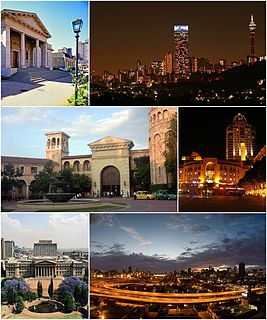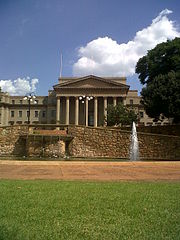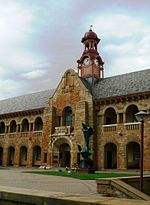Related Research Articles

Johannesburg, informally known as Jozi,Joburg or "the city of gold", is the largest city in South Africa and one of the 50 largest urban areas in the world. It is the provincial capital and largest city of Gauteng, which is the wealthiest province in South Africa. Johannesburg is the seat of the Constitutional Court. The city is located in the mineral-rich Witwatersrand range of hills and is the centre of large-scale gold and diamond trade. It was one of the host cities of the official tournament of the 2010 FIFA World Cup.

The Transvaal Colony was the name used to refer to the Transvaal region during the period of direct British rule and military occupation between the end of the Second Boer War in 1902 when the South African Republic was dissolved, and the establishment of the Union of South Africa in 1910. The physical borders of the Transvaal Colony were not identical to the defeated South African Republic, but was larger. In 1910 the entire territory became the Transvaal Province of the Union of South Africa.

Gauteng is one of the nine provinces of South Africa. The name in Sotho-Tswana means "place of gold."

Kimberley is the capital and largest city of the Northern Cape Province of South Africa. It is located approximately 110 km east of the confluence of the Vaal and Orange Rivers. The city has considerable historical significance due to its diamond mining past and the siege during the Second Boer War. British businessmen Cecil Rhodes and Barney Barnato made their fortunes in Kimberley, and Rhodes established the De Beers diamond company in the early days of the mining town.

The University of the Witwatersrand, Johannesburg, is a multi-campus South African public research university situated in the northern areas of central Johannesburg. It is more commonly known as Wits University or Wits. The university has its roots in the mining industry, as do Johannesburg and the Witwatersrand in general. Founded in 1896 as the South African School of Mines in Kimberley, it is the third oldest South African university in continuous operation.

Johannesburg is a large city in Gauteng Province of South Africa. It was established as a small village controlled by a Health Committee in 1886 with the discovery of an outcrop of a gold reef on the farm Langlaagte. The population of the city grew rapidly, becoming a municipality in 1897. In 1928 it became a city making Johannesburg the largest city in South Africa. In 2002 it joined ten other municipalities to form the City of Johannesburg Metropolitan Municipality. Today, it is a centre for learning and entertainment for all of Africa. It is also the capital city of Gauteng.

The Witwatersrand Gold Rush was a gold rush in 1886 that led to the establishment of Johannesburg, South Africa. It was a key part of the Mineral Revolution.

Vereeniging is a city located in the south of Gauteng province, South Africa, situated where the Klip River empties into the northern loop of the Vaal River. It is also one of the constituent parts of the Vaal Triangle region and was formerly situated in the Transvaal province. The name Vereeniging is derived from the Dutch word meaning "association" or "union".
The Technikon Witwatersrand was a technikon located in Johannesburg, South Africa. On 1 January 2005, it merged with Rand Afrikaans University and the Soweto and East Rand campuses of Vista University to form the University of Johannesburg. The former Vista University East Rand Campus has subsequently been permanently closed.

Springs is a main place, and formerly independent town, in the east of Ekurhuleni in the Gauteng province of South Africa. It lies 50 km (31 mi) east of Johannesburg and 72 km (45 mi) southeast from Pretoria. The name of Springs derives from the large number of springs in the area; it has an estimated population of more than 121,610 in 2011 and is situated at 1628 m (5,340 ft) a.s.l.

Krugersdorp is a mining city in the West Rand, Gauteng Province, South Africa founded in 1887 by Marthinus Pretorius. Following the discovery of gold on the Witwatersrand, a need arose for a major town in the west of the reef. The government bought part of the Paardekraal farm and named the new town after the Transvaal president, Paul Kruger. Krugersdorp no longer has a separate municipal government after it was integrated into Mogale City Local Municipality along with surrounding towns. It is now the seat of government for Mogale City.

Transvaal University College was a multi-campus public research university in South Africa which gave rise to the University of the Witwatersrand and the University of Pretoria.

Colonel John Dale Lace was a South African gold and diamond mining magnate and Randlord. He was born in Port St Mary on the Isle of Man.

The University of Pretoria is a multi-campus public research university in Pretoria, the administrative and de facto capital of South Africa. The university was established in 1908 as the Pretoria campus of the Johannesburg-based Transvaal University College and is the fourth South African institution in continuous operation to be awarded university status. The university has grown from the original 32 students in a single late Victorian house to approximately 49,000 in 2015. The University was built on 7 suburban campuses on 1,120 hectares.
This page details the South African Army order of battle in 1940, before and after the formation of expeditionary forces.

Rand Water previously known as the Rand Water Board is a South African water utility that supplies potable water to the Gauteng province and other areas of the country and is the largest water utility in Africa. The water is drawn from numerous sources and is purified and supplied to industry, mining and local municipalities and is also involved in sanitation of waste water.

Albert Hubert Halder was a German architect, civil engineer and businessman who practiced in South Africa and in the then Rhodesia in Bulawayo. Halder was born in Biezkofen, Württenberg, Germany on 9 October 1855 and died in London, England in 1901.

The Empire Exhibition, South Africa, held in Johannesburg, was intended to mark that city's jubilee and was opened by the Governor-General of the Union of South Africa on 15 September 1936. It was the first exhibition held in the Union of South Africa following two earlier exhibitions in Cape Colony in 1877 and 1892. The idea of an empire exhibition in South Africa was first discussed in 1934 by the Buy Empire Committee of Johannesburg. On 9 January 1935, the Grand Council of the Federation of British Industries passed a resolution for a proposal to hold an Empire Exhibition in Johannesburg in 1936 in conjunction with the Golden Jubilee of the city.
Hans Sauer was a South African born medical doctor, lawyer, adventurer and businessman. He is regarded as a Rand Pioneer, arriving in Johannesburg in 1886 shortly after the discovery of gold and was the town's first district surgeon. He is linked with the creation of Rhodesia.

Jan Eloff was the first civilian commissioner and the second mining commissioner in Johannesburg and the man to whom Eloff Street was named after, the first street to be surveyed. In time, 12 streets in the Greater Johannesburg area were named after him.
References
- ↑ History of Wits, retrieved 4 Sep 2012 Archived 2012-06-12 at the Wayback Machine
- ↑ "University of Pretoria - historic overview". Archived from the original on 2014-11-16. Retrieved 2012-09-04.
- ↑ SAHRA database entry for Old School of Mines, Kimberley
- ↑ Kimberley: the city that sparkles - a trip into the past Retrieved September 2012 - since removed
| This article about a South African building or structure is a stub. You can help Wikipedia by expanding it. |

